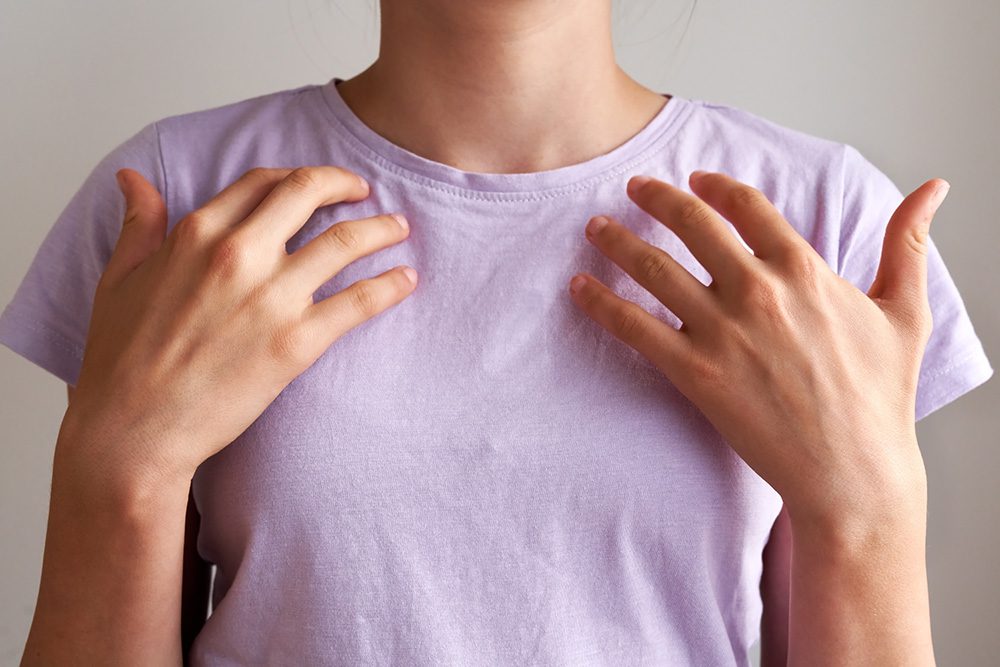Emotional freedom technique (EFT), or tapping, is an alternative therapeutic tool merging elements of ancient Chinese acupressure with modern psychology to relieve relieve stress, anxiety and emotional pain. But does it work? Aleney de Winter finds out.
Take one young child sick with COVID-19, another dealing with the trauma of schoolyard bullying, and a partner on the brink of exhaustion after months of 14-hour days. Then add a partially collapsed lung, a massive workload, back-to-back zoom meetings, and looming deadlines. And that’s just today. On a scale of one to 10, my stress levels are clocking in at a solid 11. Even if I was allowed to leave the house (the COVID patient has us all in quarantine), my recalcitrant lung is in no mood to cooperate with any of my usual go-tos for stress – a long walk, sleep, a massage, or a generously poured G&T. So, I’ve taken to tapping.
My fingers, impatiently? Noisy synchronised dancing? Some kind of plumbing activity? No, though now you mention the taps are leaking, so there go my stress levels again.
I’m talking about EFT tapping, self-help therapeutic technique that draws on the ancient Chinese practice of acupuncture and modern psychology.
So, what exactly is tapping?
Remember gently rubbing the middle of your baby’s back or patting them on the bottom to calm them when they were little? Both are prime points in acupressure, an ancient Chinese practice which teaches that the body’s energy travels along specific pathways, and amongst the most calming points for children. You might even call your motherly instincts tapping, because the theory behind it isn’t dissimilar. Minus the bottoms.
Emotional Freedom Technique (EFT) tapping is a brief intervention combining elements of cognitive therapy, and stimulation of acupressure points on the face and body. During EFT intervention, patients can identify and address a concern or issue from anxiety, cravings and insomnia to post traumatic stress disorder and physical pain, and rate their distress or pain on a subjective unit of distress scale (SUDS) out of 10. The patient uses light touch from their own fingertips (tapping) on the series of specific acupoints on the face and upper body, which sends electrochemical impulses to the part of the brain that controls stress and fear. Typically the tapping is combined with verbalisation of a specific issue or problem, followed by re-framing the issue in the context of self-acceptance. This is then repeating until the initial SUDS rating is very low. The entire process generally takes only a few minutes. And while in its early days, EFT may have been considered a little “woo”, it works and has a growing fan club that includes The Duchess of Cornwall, Whoopi Goldberg, Lily Allen, Madonna and Olympic athlete Bralon Taplin, who uses uses EFT to prepare for races.
More than 100 recent studies have demonstrated its efficacy and it is now so mainstream that it’s being successfully implemented to treat PTSD in veterans and military personnel.
EFT has been extensively investigated for anxiety and depression. In a large-scale study of 5000 patients seeking treatment for anxiety across 11 clinics, an improvement was found in 90% of patients who received acupoint tapping therapy. Clinical EFT has also been shown to improve multiple physiological markers of health, including resting heart rate blood pressure, and a significant decrease in cortisol and other stress hormones.
How does one start EFT
The good news is that tapping is a technique that’s easy to learn, and safe and easy to do anytime, anywhere, once you master it. For most people that’s quite quick, but it took me talking my daughter through an EFT Session when she was feeling a little anxious to find its power. Though I hadn’t at that stage managed to get the rhythm right for myself, I figured it couldn’t hurt and it worked for my girl in just a few minutes, just like the bottom patting had when she was tiny. Tapping also worked on my son, who is a little older and less inclined to be patient with his mother’s “crazy ideas”.
So, I revisited it for myself using the same mindset I used on the kids, and it worked so well it has become my go to for self- soothing when overwhelm strikes.
Like today… tapping has taken the energy out of the negative emotions and I’ve managed and mastered the challenges the day has thrown my way, in relative calm, instead of falling in a heap. I must confess a few well-executed and loudly expressed expletives may also have helped.
Five simple steps to EFT tapping
While I recommend beginning with an EFT Practitioner that can guide you through the process of using the EFT Technique, these five steps can be followed at home;
Step 1: Define – Think about and focus on a single issue or concern you wish to resolve.
Step 2: Test – Rank the intensity of the issue on pain on a subjective unit of distress scale (SUDS) out of 10, using 10 as a marker for the worst the issue has ever been.
Step 3: Set up – Establish a simple setup statement that describes your current issue, acknowledging the issue and convey self-acceptance in spite of it. Something along the lines of … “Even though I’m feeling anxious about [issue], I love and completely accept myself as I am.”
Step 4: Sequence – Gently tap each of the point below eight times consecutively, repeating the statement phrase three times.
- The brow – at the beginning of your eye brow, just to the side of the nose
- The side of the eye – on the bone at the outside corner of the eye
- Under the eye – on the bone under the eye
- Under the nose – between your nose and upper lip
- The chin – halfway between your lower lip and the bottom of the chin
- The collarbone – the beginning of your collarbone where your breastbone intersects
- Under the arm – about 10 cm under the armpit
- top of the head – at the centre of the top of your head,

Step 5: Test the intensity – At the end of your sequence, rank the intensity of your issue on a scale of 0–10, again and compare the results to your initial number. Repeat the process until you reach 0 or the number plateaus.
This article provides general information only, and does not constitute health or medical advice. If you have any concerns regarding your health, seek immediate medical attention.








